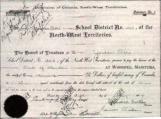14
The Debenture
5 May 1904
Yankton School, Saskatchewan

15
Once permission was gained to start a school district, the next hurdle was the financing. Debentures were a common practice. A building, a teacher and supplies made up the list of necessary acquisitions.
16
Normal School Recruit
June, 1953
Moose Jaw, Saskatchewan

17
Early School Class
20 May 1925
Oriole School, Saskatchewan

18
School Yard Layout
1930
Clapton School, Saskatchewan

19
The school yard layout usually included a barn and toilets as well as the school. Optional facilities could include a teacherage, an ice house (if no well was available), a ball diamond and/or outdoor skating rink, swings and teeter- totters.
20
A New School Blueprint
1928
McAllister School, Saskatchewan

21
School size would vary, but many were in the 5 by 6 meter range and under 33 square meters.
22
Teacher Availability
1941
Stoney Creek School District, Saskatchewan

23
The availability of teachers varied through the years, but many young instructors were female - arriving as a "Miss" and eventually staying as a "Mrs."
24
The Teacher's Life
1908
Stoney Creek School District, Saskatchewan

25
"There was a severe teacher shortage in 1948 when I graduated from high school. Someone in authority had the idea that a 'longer short course' would fill the rural schools with teachers quickly. I and many other new graduates attended the provincial Normal School in Saskatoon from July 5, 1948 to October 8, 1948. We were granted a 24T Temporary Certificate and sent forth to the rural schools of Saskatchewan. I had just turned 18, thought that I knew a lot and soon learned that there was a lot more to learn. I clearly remember thinking in March of 1949, 'If I can survive this year, no task in life will be too difficult for me to attempt.' "
26
Binder Threshing
1940
Pathlow district, Saskatchewan

27
Some schools closed longer in the winter and took fewer holidays in the summer. The school year varied, but was roughly 200 days long. Most boards were very lenient in allowing family members time off to help with farm work.